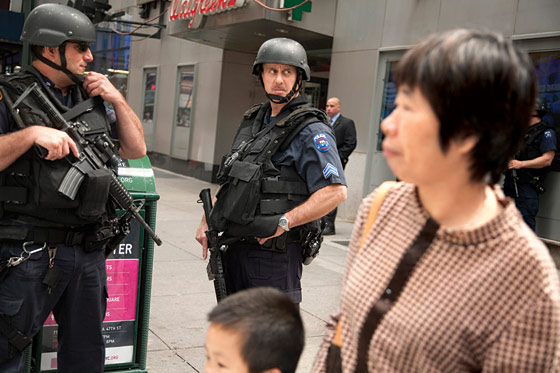
Before 9/11, just about the only place to see a law-enforcement officer with an automatic weapon was on TV. Now there are several on any given morning in Grand Central. Before the shoe bomber, we could keep our shoes on. The balance between freedom and security is constantly being recalibrated. So when Faisal Shahzad left his Pathfinder running at 45th near Broadway, with the intention of blowing it, and whatever was around it, to smithereens, it was inevitable that the debate would begin again.
Certainly we are still several steps removed from the world imagined by, say, the 1998 film The Siege, in which tanks roll down brownstone-Brooklyn streets and soldiers in camouflage march grim-faced over the Brooklyn Bridge as an Army general (played by Bruce Willis) announces that the president has imposed martial law in New York City after a series of increasingly horrific terrorist attacks. But as we learned after 9/11, “normal” is a concept that is malleable: It wasn’t like there weren’t Army vehicles in the city that year, and we’ve learned to consider men in fatigues with big guns in Grand Central unalarming—comforting, even. Random subway bag searches were challenged in court on Fourth Amendment grounds, but the courts ruled that bag searches were legal under the so-called special-needs doctrine—meaning the underlying justification for the searches is public safety, not law enforcement.
Security cameras used to feel like part of a Big Brother apparatus with echoes of Foucault’s panopticon; in this view of the world, Manhattan was a jail, we were the inmates, and the security cameras were ever watchful, always on. But what good do they do? In the hours after the bombing attempt, police were pursuing the wrong suspect because a camera caught a random guy (described as looking “furtive”) in an alley changing his shirt, while there didn’t seem to be any footage of the actual perpetrator. So should there be more cameras? England, long under siege by the IRA, now by Islamic terrorists, is full of cameras: The average U.K. resident, by some estimates, is photographed more than 300 times each day. Cars are photographed going into and out of central London—part of a congestion-pricing plan that Mayor Bloomberg wanted to emulate. But it’s also a good way of keeping track of who’s where, just as your MetroCard swipes your path through town.
Next up might be car checkpoints, in Times Square and elsewhere. “You could start to see an increased police presence on the ground,” says Kris Coleman, a former FBI agent and CIA officer who runs his own security firm. “You might see the occasional vehicle checkpoint as well.” In Times Square, “the primary purpose would be to keep this landmark area safe from explosives—not arrest people,” says Bennett Capers, a law professor at Hofstra. “Legally, it’s probably fine. It passes the special-needs test.”
And we’ll likely get used to it, in our fear, hoping we can trust the government with its new capabilities. Take “intelligent video,” which triggers an alert when a camera (keeping an eye on, say, the Brooklyn Bridge) detects something suspicious—no word yet on how it susses out “furtiveness.” Facial-recognition technology is also becoming more accurate. There’s always money to be made with newfangled devices designed to sniff out bombs: “You could have sensors along roadways, particularly at toll bridges, that would pick up minute ionic traces emitted by a vehicle that has come into contact with explosives,” says Steven Simon, a counterterrorism expert. So expect more of that: more big toys, fewer civil-liberties quibbles. Maybe this will keep us safe. Right?
Have good intel? Send tips to intel@nymag.com.